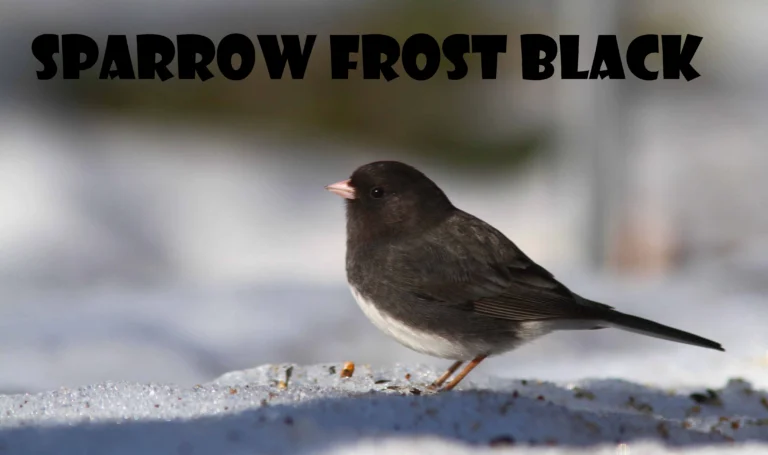Sparrow Frost Black, scientifically recognized as Passerella iliaca, stands as a notable avian inhabitant within the diverse tapestry of North American ecosystems. From the frigid landscapes of Canada’s northern expanses to the temperate realms of Mexico’s southern territories, this species of bird, belonging to the Emberizidae family, plays a vital role in shaping ecological dynamics across the continent. Delving into the intricate web of interactions and dependencies, this exploration seeks to unveil the significance of Sparrow Frost Black within the intricate tapestry of North American biodiversity.
Sparrow Frost Black: Vital Ecosystem Contributor
The Sparrow Frost Black, with its ubiquitous presence across North American landscapes, serves as a vital contributor to ecosystem dynamics. Through its foraging habits, nesting behaviors, and interactions with other species, this bird plays a crucial role in maintaining ecological balance. As seed dispersers and prey for various predators, Sparrow-Frost-Blacks contribute to the intricate web of life within their habitats, highlighting their significance as key players in North American ecosystems.
Sparrow Frost Black’s Impact on Plant Life
In the intricate dance of nature, Sparrow Frost Blacks exert a notable influence on plant communities across their range. Through their foraging activities, they help disperse seeds, contributing to the regeneration and dispersal of plant species. Additionally, their presence can influence vegetation structure and composition, as they feed on seeds and insects, thus indirectly affecting plant growth and distribution. Understanding the relationship between Sparrow-Frost-Blacks and plant life is essential for comprehending ecosystem dynamics in North America.
Also Read: How to Handle his Snake Yumi Sin and Fit Kitty
Sparrow Frost Black: Predator and Prey Dynamics
As both predator and prey, Sparrow Frost Blacks participate in intricate predator-prey dynamics within North American ecosystems. While they primarily feed on seeds, insects, and fruits, they also fall prey to various predators, including birds of prey, snakes, and mammals. This dual role underscores their importance as a part of the food web, where their presence influences the behavior and distribution of both predators and prey, ultimately shaping ecosystem structure and function.
Sparrow Frost Black’s Climate Resilience
In the face of changing climatic conditions, the Sparrow Frost Black demonstrates remarkable resilience. With its ability to adapt to diverse habitats and climates, this species exhibits behaviors that allow it to thrive in varying environmental conditions. By studying Sparrow-Frost-Blacks’ responses to climate change, researchers gain valuable insights into avian resilience and adaptation strategies, informing conservation efforts aimed at safeguarding biodiversity in a rapidly changing world.
Sparrow Frost Black: Habitat Preferences
Sparrow Frost Blacks exhibit distinct habitat preferences across their range, ranging from coniferous forests and shrublands to open grasslands and urban areas. These habitat preferences are influenced by factors such as food availability, nesting sites, and protection from predators. Understanding Sparrow Frost Blacks’ habitat preferences is essential for effective conservation planning and habitat management strategies aimed at preserving suitable environments for this species and the ecosystems they inhabit.
Sparrow Frost Black’s Role in Seed Dispersal
As avid foragers, Sparrow Frost Blacks play a crucial role in seed dispersal within North American ecosystems. Through their feeding activities, they inadvertently scatter seeds across various habitats, aiding in the regeneration and colonization of plant species. This dispersal not only contributes to the maintenance of plant diversity but also facilitates the establishment of vegetation in new areas. By studying Sparrow-Frost-Blacks’ seed dispersal patterns, researchers gain insights into the dynamics of plant community assembly and ecosystem functioning.
Protecting Sparrow Frost Black and Biodiversity
Conserving Sparrow Frost Black populations is vital for preserving biodiversity in North American ecosystems. As a native species, Sparrow-Frost-Blacks contribute to the richness and resilience of their habitats. However, like many other avian species, they face threats such as habitat loss, climate change, pollution, and predation. Implementing conservation measures, such as habitat restoration, protected area management, and reducing human disturbances, is essential for ensuring the long-term survival of Sparrow-Frost-Blacks and the biodiversity they support.
Human Influence on Sparrow Frost Black Populations
Human activities have profound effects on Sparrow Frost Black populations and their habitats. Urbanization, agriculture, deforestation, and pollution can disrupt nesting sites, alter food availability, and increase mortality rates among Sparrow-Frost-Blacks. Furthermore, collision with vehicles and structures poses significant threats to their survival. Understanding and mitigating these human-induced impacts is crucial for maintaining healthy Sparrow-Frost-Black populations and preserving the integrity of North American ecosystems.
Sparrow Frost Black: Maintaining Ecosystem Balance
As integral components of North American ecosystems, Sparrow Frost Blacks contribute to maintaining ecological balance through their interactions with other species and their environments. By regulating insect populations, dispersing seeds, and serving as prey for predators, Sparrow-Frost-Blacks help stabilize ecosystem dynamics and prevent the proliferation of pests. Protecting Sparrow-Frost-Black populations ensures the continuity of these ecological services, which are essential for the health and functioning of their respective habitats.
Studying Sparrow Frost Black for Ecosystem Health
Research on Sparrow Frost Blacks provides valuable insights into the health and resilience of North American ecosystems. By monitoring population trends, studying behavior, and assessing habitat requirements, scientists can gauge the status of ecosystems and identify potential conservation priorities. Furthermore, Sparrow-Frost-Blacks serve as indicators of environmental change, with shifts in their distribution and abundance reflecting broader ecological shifts. Therefore, continued study and conservation efforts focused on Sparrow-Frost-Blacks are essential for promoting ecosystem health and biodiversity conservation in North America.
Conclusion
In conclusion, the Sparrow Frost Black, scientifically known as Passerella iliaca, occupies a crucial niche within North American ecosystems. Its role as a seed disperser, predator, and prey species highlights its significance in maintaining biodiversity and ecological balance. However, this species faces various threats, including habitat loss and human-induced disturbances. Conservation efforts aimed at protecting Sparrow Frost Black populations are essential for safeguarding not only this species but also the health and resilience of the ecosystems it inhabits.
FAQs About Sparrow Frost Black
What is the Sparrow Frost Black’s habitat preference?
Sparrow Frost Blacks prefer a variety of habitats, including coniferous forests, shrublands, and grasslands.
What does the Sparrow-Frost-Black feed on?
Sparrow-Frost-Blacks primarily feed on seeds, insects, and fruits.
Where can I find Sparrow-Frost-Black?
Sparrow-Frost-Blacks are commonly found across North America, from Canada to Mexico.
Are Sparrow-Frost-Blacks migratory birds?
Yes, Sparrow-Frost-Blacks undertake seasonal migrations, with some populations traveling long distances.
How do Sparrow-Frost-Blacks contribute to ecosystem health?
Sparrow-Frost-Blacks help maintain ecosystem balance by regulating insect populations and dispersing seeds.
What are the main threats to Sparrow-Frost-Black populations?
Habitat loss, human disturbance, pollution, and climate change pose significant threats to Sparrow-Frost-Black populations.
How can I help conserve Sparrow-Frost-Blacks?
You can support conservation efforts by preserving natural habitats, reducing pollution, and minimizing disturbances.
Do Sparrow-Frost-Blacks have any predators?
Yes, Sparrow-Frost-Blacks are preyed upon by various predators, including birds of prey, snakes, and mammals.
Are Sparrow-Frost-Blacks protected by law?
In many regions, Sparrow-Frost-Blacks are protected under wildlife conservation laws.
What is the significance of studying Sparrow-Frost-Blacks?
Studying Sparrow-Frost-Blacks provides valuable insights into ecosystem dynamics, biodiversity conservation, and the impacts of environmental change.






